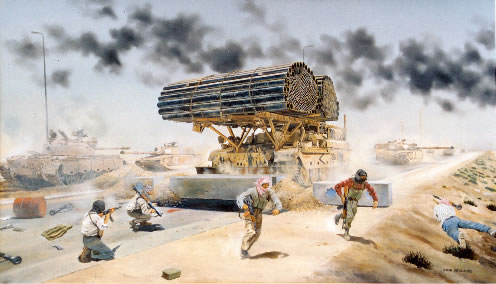
"The Entry into Al Basrah"
Ref: DR114
by David Rowlands
Giclee Print
58 x 38 cm
At 14.30 hrs on 1st April 2003, an Armoured Vehicle Royal Engineers (AVRE), call sign 31A, led a column of armoured vehicles to smash an enemy barricade at junction Red 4, approaching the “Gateway to Basrah”. The AVRE was commanded by Corporal Peter Chilton, driven by Sapper McLaughlin and crewed by Sapper Bussey. Following the AVRE was a Challenger 2 tank (call sign 41) of B Squadron, The Royal Scots Dragoon Guards. Behind that were three Warriors of the Irish Guards, and at the rear of the column was a Challenger Armoured Recovery and Repair Vehicle (CRARRV) (call sign 24C) of 31 Armoured Engineer Squadron, ready to recover any immobilised vehicles.
To their right, a British armoured column was advancing on the other side of the dual carriageway. A Challenger 2 tank (call sign 40) of B Squadron, commanded by Capt John Stone, was leading a Warrior, followed by a Challenger 2 (call sign 42), then a Warrior, then the Challenger 2 of the CO Scots DG (call sign 11B).
The roadblock consisted of concrete blocks and oil drums, with a T55 tank which was being engaged by the lead British tanks. High explosive rounds and 7.62mm Chain Guns from the Warriors were being fired into the barricade itself. Fedayeen Saddam fighters, in their distinctive red and white scarves, were firing rocket propelled grenades and AK47 rifles from the barricade at close quarters.
During my time in Basrah I travelled on Route Red many times. I interviewed Corporal Chilton and his crew shortly after the action and sketched the AVRE. He had attached an empty small-arms ammunition box on the side for extra stowage. The spare plough (blade), normally carried on the rear deck, was removed for this operation. As there was no intention to unroll the fascines during this task, the blow-out pin head was not inserted and the fascines were held together securely by the three chains, the normal practice when travelling (and especially if the plan is to hit a concrete barricade). The left smoke grenade discharger had broken off a few days earlier.
He told me, “We were going at full speed. Just before hitting the barricade we dropped down to 4th gear, for more power. The T55 tank was dug in a bit. The long concrete blocks had earth banked round them. After breaching the barricade, we proceeded for another thirty yards. There were reports of mines said to be around the barricade, but we didn’t see any, nor set any off.” When they struck the barricade, one push was sufficient and the long concrete blocks came to rest near the central reservation. With the Warriors of the Irish Guards, they then dominated the ground for half an hour, drawing enemy fire, before withdrawing back along Route 4 to the “home” bank of the Shatt al Basra.
